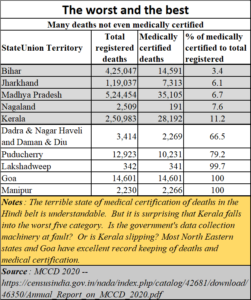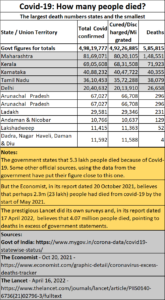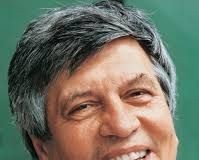[The image above was created by using Bing’s ChatGPT. The image was the genius of MM]
India’s poor record-keeping about deaths and ghost voters
RN Bhaskar
On May 22, 2023, there were news reports about the Home ministry planning to introduce a new Bill in the Parliament. The Bill would seek to link birth and death registers with electoral rolls, the minister was quoted as saying (https://www.thehindu.com/news/national/bill-to-link-death-and-birth-register-with-electoral-rolls-in-next-session-of-parliament-amit-shah/article66882038.ece). That would clean out ghost voters.
 The minister said registration of births and deaths is important for updating citizens’ register, electoral rolls and list of people who avail of beneficiary schemes. He did not make any mention about when the next Census (due in 2021) would be held but claimed that the registration of births and deaths helps in making development plans in the intermittent period between the two Censuses.
The minister said registration of births and deaths is important for updating citizens’ register, electoral rolls and list of people who avail of beneficiary schemes. He did not make any mention about when the next Census (due in 2021) would be held but claimed that the registration of births and deaths helps in making development plans in the intermittent period between the two Censuses.
He also said that the earlier Census was not accurate. “The government will now conduct the Census electronically where every person will have the right to fill the data which will be verified and audited. This will include more than 35 parameters of socio-economic status.”
Missing dead
The home minister’s explanations appear extremely plausible and logical, but for one major flaw. India has leaky records about deaths, with far more holes than those of the Census of India. Some of these issues were brought to the attention of India’s policymakers in June 2021 (https://asiaconverge.com/2021/06/missing-dead-series/) but evidently the minister had not been updated on the problems with India’s death records.
 The first chart explains how as many as 20% to 70% of the deaths taking place in India are not even recorded. This comes to around 20 lakh to 50 lakh deaths each year. This in addition to at least 20 lakh deaths not even being medically certified (20-22%).
The first chart explains how as many as 20% to 70% of the deaths taking place in India are not even recorded. This comes to around 20 lakh to 50 lakh deaths each year. This in addition to at least 20 lakh deaths not even being medically certified (20-22%).
The large variation in numbers is because of two reasons. First no government website gives data on India’s death rate. Niti Aayog began giving out such data, but stopped after 2016 (https://www.niti.gov.in/content/death-rate). At that time, it gave the rough or crude estimate of the death rate in India at 6.4 per 1000 people. But the World Bank gives such information in greater detail. It points out how India’s death rate soared from around 7 deaths per 1000 (that is the level where it stayed for almost five years) to 9.4 per 1000 people in 2021. The rate of 9 deaths per 1000 has been echoed by other websites and databases too.
Hence, we have taken the figures at the rate of 7 per 1000 people and also 9.4 per 1000. Obviously, the results from both ratios are bound to be different.
But this poses several problems. If 20 lakh to 50 lakh deaths are ‘missing’, India’s numbers of the living must have soared by 20 lakh x 10 years at the very minimum if the Census were to be held in 2021. That results in 2 to 5 crore ghost voters and ration card holders (even Aadhaar card holders). Death records have begun to pose a serious problem for any serious student of population studies in India.
And this is where one confronts another problem. One does not even know if the MCCD data can be relied upon. Look at the five states which had the poorest registrations of the medical cause of death. Among the five is Kerala, which is known to be scrupulous about record keeping a d registering deaths. It is also the most literate state. This requires further investigation.
As for the Hindi belt, it is not surprising that many deaths do not come with a medical certificate, or are even recorded. An oral statement, or perhaps a communication of the crematorium is usually the best source for updating records, if at all. That further complicates the data about deaths in India.
 One reason nobody has paid much attention to recording of deaths, through successive governments, is because a dead person not reported as being dead has several advantages for the dead person’s relatives, and for politicians alike.
One reason nobody has paid much attention to recording of deaths, through successive governments, is because a dead person not reported as being dead has several advantages for the dead person’s relatives, and for politicians alike.
The family of the dead person continues to get the entitlements accruing to the deceased. This includes subsidised grain, oil etc. through ration shops (This system of entitlements has now moved from the ration card to the Aadhaar card). Hence inflated numbers of the living help family members benefit.
The politician also benefits, because a “living dead” has an Aadhaar card, and an election card. His or her name has not been struck off electoral rolls. This allows for bogus voting as well, aided by bogus Aadhaar cards (https://bhaskarr.substack.com/p/indias-election-peril-aadhaar-and?sd=pf – free substack subscription).
When so many deaths are not even registered then surely linking these death records with election rolls would be more flawed than linking Census data with electoral rolls. Moreover, electronic registration would first require the electronic Aadhaar database being sanitised first.
Covid deaths
Another big problem with registering the true number of deaths is the government’s reluctance to get the Covid-19 death rates verified by independent bodies like the Tata Institute of Social Sciences, one of the IIMs or XLRI. This is because there’s a thick fog surrounding the number of Covid-19 dead.
Take the government data first. Much of the data comes from the MCCD 2020 – an acronym for Report on Medical Certification of Cause of Death – 2020 (a pdf copy of the report can be downloaded from https://www.mygov.in/corona-data/covid19-statewise-status/). The table displaying data for all states can be downloaded from https://asiaconverge.com/wp-content/uploads/2023/05/2023-05-30_Covid-deaths-full.png.
The government claims that around 5.85 lakh people died on account of Covid 19. But studies by a team of researchers from The Economist came out with a startlingly different  set of figures. These numbers can be found in its report dated 20 October 2021 which states that 2.3 million had died (that is 23 lakh, not 5.8 lakh). The Economist’s analysis can be found at https://www.economist.com/graphic-detail/coronavirus-excess-deaths-tracker).
set of figures. These numbers can be found in its report dated 20 October 2021 which states that 2.3 million had died (that is 23 lakh, not 5.8 lakh). The Economist’s analysis can be found at https://www.economist.com/graphic-detail/coronavirus-excess-deaths-tracker).
But a more detailed survey was also undertaken by the prestigious Lancet. It put the number of dead at over 4.07 million (40 lakh). The Lancet claims that there was considerable underreporting surrounding the number of people who had died on account of Covid-19. Such claims were reinforced by daily reports brought out by Dainik Jagran, till such surveys had to be called off. The Lancet report can be found at https://www.thelancet.com/journals/lancet/article/PIIS0140-6736(21)02796-3/fulltext).
Aadhaar complexities
And this brings us to the last point. Cleaning up the death registrations would have been a straightforward matter had it not been for inflating in the number of Aadhaar cards issued. As pointed out in an earlier article (https://bhaskarr.substack.com/p/indias-election-peril-aadhaar-and?sd=pf – free substack subscription) , at least 9 states have more Aadhaar cards issued than their entire population. Even at the national level, 94.8% of the population having Aadhaar cards appears to be on the higher side.
Link this problem with a sudden surge in the number of cards by some states (mostly border states). Our definition of surge is based on a simple point of reference. India’s birth rate is 1.67% per annum. Thus, if a territory shows a surge in the number of Aadhaar cards of over 2% within a 15-month period, there should be cause for alarm. If no flags were raised, one should ask why the dogs did not bark.
 Government data shows that at least 20 states witnessed such a surge. This is extremely serious.
Government data shows that at least 20 states witnessed such a surge. This is extremely serious.
Solutions
With poor record keeping about deaths in the non-Covid years, and the huge, alleged underreporting about Covid deaths, there appear to be only two mechanisms which can allow the actual picture to emerge.
One is through the Census. The other is through the CAG (Comptroller and Auditor General).
It is to the latter authority that social activist and former secretary to the government of India, E A S Sarma, wrote a letter recently. Sarma requested him to intervene quickly to prevent erosion of public funds on the one hand and the loss of credibility of the forthcoming elections on the other (https://bhaskarr.substack.com/p/a-complaint-letter-to-the-cag-by?sd=pf – free substack subscription).
That is why linking of deaths with the electoral rolls is of no use. Ghost voters will still be around – in very large numbers. You need the Census this time. And while there is no legal requirement for holding a Census every ten years (https://indianexpress.com/article/explained/unplanned-population-un-population-funds-annual-report-on-population-indias-population-8625414/), there are three reasons why a Census is urgently needed now:
First, it is a very important convention, unbroken since independence. There is no good reason to break it now.
Second, the Census provides the very framework within which economic, financial, and even sociological policy decisions are taken. It is a must, especially in these volatile times.
Third, the uncertainty about deaths, electoral rolls and the inflated Aadhaar cards require a Census urgently. Policymakers can add supplementary requirements on a war footing and get this done. Alternatively, the CAG may have to step in.
If none of these work, India will have to face an election with ghost voters casting their votes in the ballot box.
Might as well call off the elections and used stuffed ballot boxes instead.





































COMMENTS